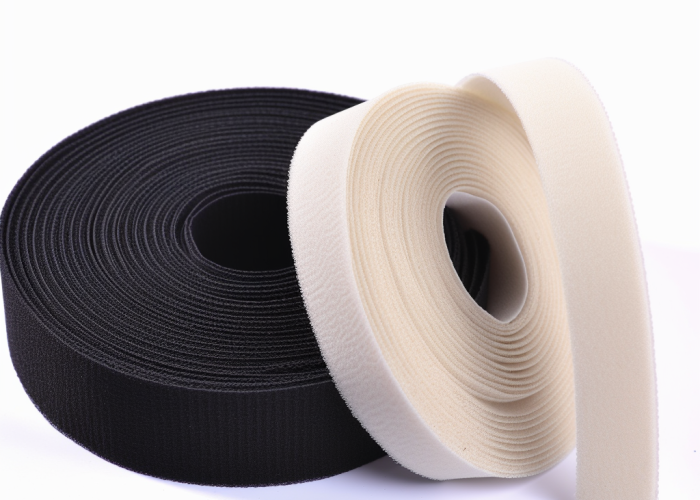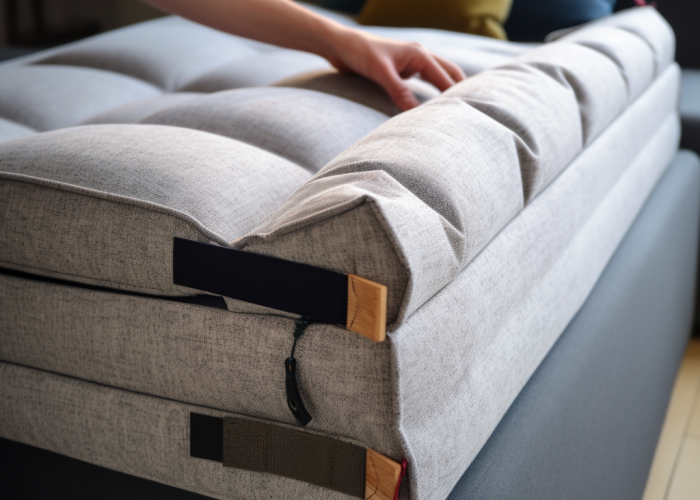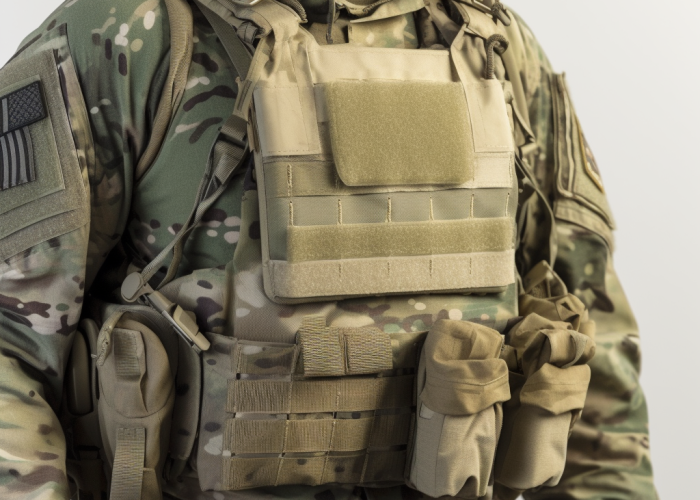As custom webbing manufacturers, we engineer hook and loop fastening systems that meet specific performance requirements for heavy-duty applications. Our specialized manufacturing capabilities deliver solutions that outperform standard options when maximum strength, environmental resilience, and long-term reliability are essential.
The ideal hook and loop combination for heavy-duty use is Hook 88 paired with Loop 9000. This industry-standard pairing delivers exceptional tear and shear resistance, making it ideal for demanding industrial, commercial, and heavy-duty applications where reliable performance under stress is critical.
Explore hook and loop performance, compare nylon vs. polyester, and get expert tips to choose the right fastening solution for your application.


Webbing manufacturing expert with 15+ years of experience helping product developers build high-performance straps for industrial, medical, and outdoor use.
Hook 88 paired with Loop 9000 is the industry standard for heavy-duty applications because it offers superior tear and shear strength while maintaining excellent durability through repeated use cycles. This combination provides exceptional holding power that makes it ideal for demanding industrial, commercial, and high-stress applications.
The superior engagement between Hook 88’s precisely engineered hooks and Loop 9000’s specialized woven structure creates a mechanical bond that significantly outperforms standard hook and loop fasteners. This design excels particularly in applications where maximum grip is required.
The combination remains secure even when subjected to vibration, movement, or varying loads – conditions that would cause standard hook and loop to fail. This reliability makes it the preferred choice across automotive, manufacturing, and equipment industries where component security is essential.
Textured hook (like HTH 707VFT) paired with Loop 9000 is the optimal choice for maximum strength in static or low-frequency cycled applications. This specialized combination delivers enhanced holding power compared to standard hook and loop pairings, making it ideal for critical applications where fastener failure is not an option.
The textured hook design features a more aggressive engagement pattern that creates stronger mechanical bonds with Loop 9000’s woven structure. This results in significantly higher initial attachment strength, which is crucial for supporting heavier loads or providing additional security in high-stress environments.
While this combination excels in static applications, it’s less ideal for scenarios requiring frequent access. The aggressive hook design that provides superior holding power also makes separation more difficult and may reduce cycle life compared to Hook 88 with Loop 9000.
Hook and loop fasteners perform exceptionally well in industrial settings when properly selected for the specific application requirements and environmental conditions. The right combinations provide reliable, adjustable fastening solutions that outperform traditional mechanical fasteners in many industrial scenarios.
For industrial applications, holding strength is a primary consideration. Premium hook and loop combinations can support substantial loads when properly sized for the application. The distribution of forces across the entire fastener area creates a secure connection that resists separation even under vibration or movement that might cause traditional fasteners to loosen over time.
Cycle life is another critical factor in industrial environments. Hook 88 with Loop 9000 maintains consistent performance through numerous engagement cycles, making it suitable for applications requiring periodic access or adjustment. For less frequently accessed components, textured hook options provide enhanced holding power at the expense of reduced cycle life.
Environmental conditions in industrial settings present additional challenges. Exposure to oils, chemicals, moisture, and temperature extremes can degrade standard hook and loop fasteners. For these demanding environments, specialized combinations like polyester hook and loop offer superior resistance to environmental factors.

Polyester and nylon hook and loop fasteners each offer distinct performance characteristics that make them suited for different heavy-duty applications. Nylon excels in strength and durability, while polyester provides superior environmental resistance to moisture, UV exposure, and chemicals.
Nylon hook and loop is known for its high tear and shear strength, as well as a longer cycle life. The material’s inherent flexibility and elasticity allow it to maintain structural integrity even after repeated use. This makes nylon the preferred choice for applications requiring frequent access while maintaining secure fastening.
Polyester hook and loop offers strong holding power comparable to nylon but with significantly better resistance to environmental degradation. It does not absorb water, maintaining its performance when wet, and resists damage from UV exposure, chemicals, and temperature fluctuations. These properties make polyester the superior option for outdoor, marine, and high-moisture environments.
Cost considerations also factor into material selection. Polyester hook and loop is generally more expensive than standard nylon but offers better value in environments where nylon would rapidly degrade due to moisture or UV exposure. In controlled indoor environments, nylon typically provides the better cost-to-performance ratio.
Choose nylon hook and loop for indoor or controlled environments where strength and cycle life are priorities, and select polyester for outdoor, marine, or high-moisture applications where environmental resistance is essential. This fundamental guideline helps engineers select the optimal material for specific heavy-duty requirements.
For heavy-duty indoor applications with minimal exposure to moisture, UV, or chemicals, nylon hook and loop (particularly Hook 88 with Loop 9000) delivers superior performance. Its exceptional strength, durability, and repeated-use characteristics make it ideal for industrial equipment, interior automotive components, and general manufacturing applications.
Polyester hook and loop becomes the better choice when environmental factors come into play. Its excellent resistance to moisture makes it suitable for applications where exposure to water, high humidity, or cleaning processes would compromise nylon’s performance. Additionally, polyester’s UV stability makes it appropriate for outdoor applications where sun exposure would quickly degrade nylon fasteners.
The decision ultimately requires balancing performance requirements against environmental conditions. In borderline cases, consider the most challenging aspect of your application environment and select the material best suited to address that specific challenge.
Environmental factors significantly impact hook and loop performance, with moisture, UV exposure, temperature extremes, and chemical contact being the most critical variables affecting durability and holding strength. Understanding these effects is essential for selecting the appropriate fastener for specific application environments.
Moisture represents one of the most significant challenges for hook and loop systems. Nylon absorbs water and does not perform well when wet, experiencing up to 20% reduction in holding strength and accelerated degradation with prolonged exposure. Polyester excels in damp or wet conditions, maintaining its performance characteristics even with regular moisture contact.
UV radiation damages hook and loop materials over time, particularly nylon varieties. Prolonged sun exposure causes nylon to become brittle and lose holding power. Polyester offers significantly better UV resistance, making it appropriate for outdoor applications where sunlight exposure is unavoidable.
Temperature fluctuations affect both materials differently. Nylon maintains better flexibility in cold environments but has lower heat resistance. Polyester exhibits higher temperature stability, performing better in applications exposed to high heat or significant temperature variations.
Chemical exposure from oils, solvents, or cleaning agents can deteriorate fastener materials. Polyester generally provides better chemical resistance compared to nylon, though specialized formulations are available for particularly challenging chemical environments.

Industries dealing with extreme environments, safety-critical applications, or demanding performance requirements benefit most from specialized hook and loop fasteners. Marine, automotive, aerospace, medical, and outdoor equipment manufacturers particularly value purpose-engineered fastening solutions for their unique challenges.
The marine industry requires fasteners that withstand constant moisture exposure, salt spray, and UV radiation. Polyester hook and loop excels in these conditions, maintaining performance integrity where standard fasteners would rapidly degrade. Boat covers, equipment mounts, and interior components all benefit from moisture-resistant polyester options.
Automotive manufacturing utilizes hook and loop extensively for both interior and exterior applications. Interior components typically use nylon for its strength and cycle life, while exterior applications demand polyester’s environmental resistance. The vibration resistance of premium hook and loop combinations makes them ideal for securing components that must remain accessible for maintenance.
The aerospace sector relies on specialized hook and loop that meets stringent performance and safety standards. These applications often require flame-retardant properties, extreme temperature resistance, and consistent performance under varying pressure conditions. Custom-engineered solutions provide the specific characteristics needed for these demanding environments.
Outdoor equipment manufacturers depend on UV-resistant and weatherproof fastening solutions. From camping gear to agricultural equipment, these applications expose fasteners to harsh environmental conditions that quickly degrade standard options. Polyester hook and loop with enhanced UV stabilizers delivers the durability required for long-term outdoor use.
Selecting the right hook and loop fastening system is crucial for heavy-duty applications. Whether you need Hook 88 with Loop 9000 for maximum strength or specialized polyester options for environmental resistance, our engineering team can develop custom solutions tailored to your specific requirements. Partner with us to create high-performance fastening systems that deliver reliable results in your most demanding applications.
Hook 88 with Loop 9000 provides superior holding strength, excellent durability through repeated use cycles, and reliable performance under stress. This combination outperforms standard hook and loop by approximately 30-40% in holding power while maintaining secure connections even when subjected to vibration and movement.
Hook 88 maintains its holding strength through significantly more attachment cycles than standard hook products. While typical hook and loop may show performance degradation after 1,000 cycles, Hook 88 with Loop 9000 maintains consistent holding power through several thousand engagement cycles, making it ideal for applications requiring frequent access.
Nylon hook and loop is preferred for indoor or controlled environmental applications where maximum strength and frequent reattachment are required. It delivers superior performance in climate-controlled settings, offers better cycle life for frequently accessed components, and provides more cost-effective solutions for applications not exposed to moisture or UV radiation.
Polyester hook and loop maintains consistent performance in wet conditions while nylon experiences up to 20% strength reduction when exposed to moisture. Polyester’s hydrophobic properties prevent water absorption that would compromise holding power, making it essential for marine applications, outdoor equipment, and environments with high humidity or cleaning requirements.
Polyester hook and loop is commonly used in marine, outdoor equipment, medical, and exterior automotive applications. These industries require fasteners that withstand moisture, UV radiation, and cleaning chemicals without performance degradation. Our engineering team can develop specialized polyester hook and loop solutions tailored to your industry’s specific environmental challenges.